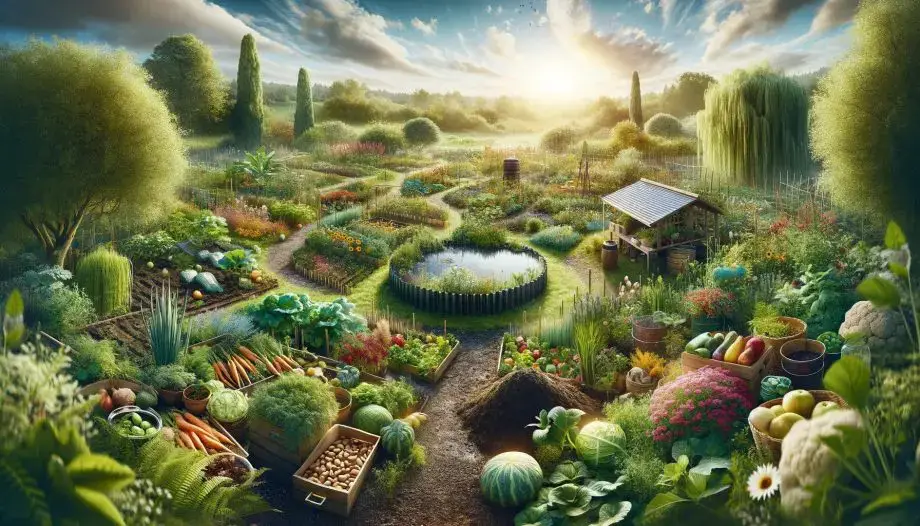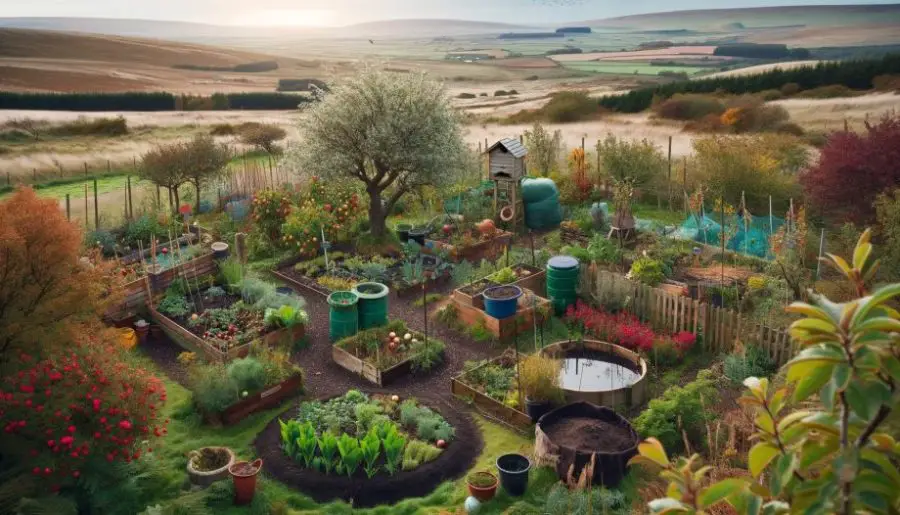

Dive into the professionals and cons of permaculture with our full knowledge! Uncover sustainable residing’s rewards and challenges.
Permaculture Execs and Cons Key Takeaways:
- Permaculture Execs and Cons: Execs embody enhanced biodiversity, soil correctly being, and water conservation.
- Cons comprise excessive preliminary prices, labor depth, and adaptation challenges.
- Permaculture promotes sustainability nonetheless requires effort and time to know its full advantages.
Welcome to our exploration of the professionals and cons of permaculture! This sustainable approach to residing has sparked widespread curiosity, nonetheless what are its exact impacts?
Be a part of us as we uncover the truths, advantages, and hurdles of permaculture in a sensible, partaking approach.
The Execs and Cons of Permaculture
Permaculture is an idea that’s turning into an rising variety of vital in correct this second’s world.
It’s a sustainable way of life, integrating human prepare with pure setting to create terribly setting nice ecosystems.
This method isn’t virtually rising meals; it’s a philosophy that encompasses various environmental and social features.
As we delve into permaculture, we’ll uncover its pretty an a variety of benefits and a few challenges it faces, providing a complete understanding of this modern observe.
What’s Permaculture?
Permaculture, a time interval that has garnered heaps consideration in sustainable residing circles, is bigger than solely a method of gardening.
It’s a design philosophy that harmonizes human residing with the pure setting.
This half explores what permaculture actually is and traces its fascinating origins.
Defining Permaculture
Permaculture is an stylish framework for sustainable residing and agricultural observe.
Derived from everlasting agriculture and everlasting customized, it seeks to create residing environments which can be each sustainable and self-sufficient.
This method entails designing landscapes that mimic patterns present in nature, aiming to create ecosystems which can be diversified, resilient, and useful to each people and the setting.
The Three Core Tenets of Permaculture
- Earth Care: Prioritizing the correctly being and well-being of our planet.
- Individuals Care: Guaranteeing that the methods we create are useful to people and communities.
- Honest Share: Selling equality and limiting consumption to confirm sources are distributed pretty.
The Origins of Permaculture
Permaculture was first conceptualized all through the Nineteen Seventies by Australians Invoice Mollison and David Holmgren.
It emerged as a response to the environmentally damaging practices of present agriculture.
They envisioned a system of agriculture that was not solely productive nonetheless in addition to labored in concord with nature.
This imaginative and prescient led to the event of ideas that knowledge the design and implementation of sustainable residing environments world massive.
Key Tips of Permaculture
Permaculture is guided by quite a few ideas, akin to:
- Assertion and Interplay: Understanding nature by observing and dealing with it, significantly than within the course of it.
- Catch and Retailer Vitality: Using pure sources like rainwater and daylight efficiently.
- Produce No Waste: Creating methods the place all components are utilized and nothing is wasted.
- Design from Patterns to Particulars: Beginning with a broad overview after which specializing inside the specifics.
By understanding what permaculture is and the place it comes from, we’re going to acknowledge its place in correct this second’s world as an answer for sustainable and moral residing.
Half 1: Execs of Permaculture

1. Low price of Waste
Permaculture stands out for its distinctive effectivity in useful helpful useful resource use.
This method prioritizes the low price of waste, guaranteeing that each ingredient contained within the ecosystem serves quite a few options.
As an illustration, plant waste is often grew to grow to be compost, which then enriches the soil.
This spherical mannequin of utilizing and reusing sources minimizes waste output considerably, setting an event for sustainable residing practices which can be utilized earlier farming.
2. Improved Soil Top of the range
Healthful soil is the muse of any worthwhile permaculture system.
Strategies like composting, mulching, and canopy cropping play an very important place in enhancing soil correctly being.
These strategies improve soil fertility, enhance its growth, and enhance its potential to retain water and dietary nutritional vitamins.
The result’s a thriving, nutrient-rich soil that helps diversified flora and contributes to the ultimate correctly being of the ecosystem.
3. Water Conservation
Permaculture areas a powerful emphasis on setting nice water use.
Strategies akin to rainwater harvesting, drip irrigation, and the creation of swales are frequent practices.
These strategies assist in decreasing water wastage, guaranteeing that each drop is used effectively.
By mimicking pure methods, permaculture designs can maintain moisture ranges and scale back regular water consumption, making them significantly useful in areas going by the use of water shortage.
4. Elevated Biodiversity
Range is a key ingredient in permaculture. By incorporating numerous vegetation, animals, and microorganisms, permaculture methods promote a balanced ecosystem.
This differ not solely enhances the resilience of the system nonetheless in addition to helps various wildlife.
Elevated biodiversity helps in pest administration, and pollination, and maintains the ultimate correctly being of the setting.
5. Resilience to Native local weather Change
Permaculture methods are inherently adaptable, making them well-suited to face up to the challenges posed by native local weather change.
The variability and redundancy constructed into these methods make sure that they are resilient to excessive native climate occasions.
Permaculture’s give consideration to native sources and self-sufficiency furthermore means these methods can elevated deal with the impacts of worldwide native local weather shifts.
6. Native Meals Manufacturing
Permaculture encourages the native manufacturing of meals, which reduces the reliance on industrial agriculture and long-distance transportation.
This method not solely helps native economies nonetheless in addition to ensures brisker, further nutritious produce.
Native meals manufacturing furthermore fosters a method of group. Residing in a permaculture group individuals come collectively to develop and share meals.
7. Further Advantages
Permaculture affords a plethora of further benefits:
- Ecosystem Suppliers: Helps pure pollinators and pest administration, enhancing crop manufacturing and ecological stability.
- Carbon Sequestration: By selling healthful soils and perennial plantings, permaculture helps in storing carbon, thus combating native local weather change.
- Neighborhood Organising: Permaculture duties usually carry individuals collectively, fostering collaboration and strengthening native meals networks.
- Decrease Enter Necessities: These methods decrease the necessity for artificial fertilizers and pesticides, relying as an alternative on pure processes.
- Regenerative Land Administration: Permaculture contributes to rehabilitating and bettering degraded lands.
- Further healthful Life-style: Collaborating in permaculture practices promotes bodily prepare and a further healthful meals plan.
- Financial Advantages: By decreasing reliance on bought inputs and fostering native commerce, permaculture can stimulate native economies.
- Consciousness and Teaching: It raises consciousness about sustainable practices and environmental stewardship.
Half 2: Cons of Permaculture

Whereas permaculture affords pretty an a variety of benefits, it’s vital to acknowledge its challenges.
Understanding these drawbacks is vital for anybody contemplating adopting permaculture practices.
On this half, we’ll uncover the assorted cons, starting from financial points to sensible limitations, giving a well-rounded view of permaculture’s have an effect on.
1. Excessive Preliminary Prices
Establishing a permaculture system could very effectively be costly. The preliminary funding accommodates land preparation, searching for perennial vegetation, and establishing water methods.
These prices sometimes is a barrier, notably for small-scale farmers or people.
Whereas these investments usually repay in the long run, the upfront expense could very effectively be vital and can deter some from adopting permaculture practices.
2. Transient-Time interval vs. Extended-Time interval Advantages
The advantages of permaculture, akin to improved soil high quality and biodiversity, usually take time to manifest.
This delay could very effectively be robust, significantly for lots of who depend on fast returns.
Farmers transitioning from regular to permaculture farming may face short-term yield reductions prior to the long-term advantages develop to be evident, posing monetary challenges in the course of the transition interval.
3. Adaptation and Acceptance Challenges
Permaculture sometimes is a crucial departure from customary farming strategies.
This new approach would possibly face skepticism from regular farmers and might battle with native customs and practices.
Moreover, sure non secular beliefs couldn’t align with some permaculture practices, perhaps creating social and cultural obstacles to its adoption.
4. Sensible Limitations
With out chemical pesticides, permaculture methods may expertise elevated pests and illness challenges.
There’s furthermore a major lack of widespread knowledge and understanding of permaculture methods, which might hinder their setting pleasant implementation.
Moreover, permaculture is perhaps not relevant for large-scale, world meals manufacturing, which poses a problem in addressing the meals wishes of the rising world inhabitants.
5. Labor and Time
Permaculture usually requires further handbook labor and time funding as in contrast with regular farming.
The design and upkeep of those methods, notably all through the preliminary ranges, could very effectively be labor-intensive.
This facet sometimes is a deterrent for these with restricted time or bodily potential, making it quite a bit a lot much less fascinating to a wider viewers.
6. Further Challenges
- Aesthetic Points: Permaculture websites may appear untidy or quite a bit a lot much less manicured as in contrast with customary gardens or farms, which can very effectively be quite a bit a lot much less fascinating to some.
- Decrease Manufacturing: In some circumstances, permaculture might be not as setting pleasant in producing massive components of meals, notably in robust environments.
- Larger Shopper Prices: Attributable to decrease manufacturing volumes and intensive labor, merchandise from permaculture methods could very effectively be costlier for shoppers.
- Hazard of Contamination with Transgenic Crops: Sustaining a 100% pure and ecological crop could very effectively be robust, notably with the hazard of contamination from shut by regular farms.
- Slowed Financial Progress: Shifting to permaculture may quickly gradual financial progress in areas counting on industrial agriculture.
- Disagreeable Odor: Processes like composting can produce sturdy odors, which is possibly disagreeable for some people.
- Time to Understand Advantages: The optimistic outcomes of permaculture on the setting and biodiversity would possibly take years to develop to be evident.
The Execs and Cons of Permaculture FAQs

Permaculture is a subject wealthy with curiosity and inquiry. Correct proper right here, we cope with some ceaselessly requested questions, offering clear, concise choices to assist deepen your understanding of permaculture.
Q: What precisely is permaculture?
A: Permaculture is an approach to land administration and philosophy that adopts preparations noticed in flourishing pure ecosystems.
It entails creating sustainable and self-sufficient agricultural methods by integrating land, sources, individuals, and the setting.
Q: How does permaculture differ from customary farming?
A: In distinction to conventional farming, which constantly is decided by single-crop cultivation and intensive use of chemical compounds, permaculture emphasizes biodiversity, ecological sustainability, and pure farming methods.
It aims to create a harmonious, interdependent system the place every ingredient advantages the others.
Q: Can permaculture be practiced in metropolis areas?
A: Sure, permaculture a permaculture yard could very effectively be tailored to metropolis settings. Metropolis permaculture entails using small areas like rooftops, balconies, and backyards to create sustainable gardens.
It incorporates ideas like vertical gardening, composting, and rainwater harvesting to revenue from restricted metropolis areas.
Q: Is permaculture a viable reply to world meals safety?
A: Permaculture has the potential to contribute considerably to meals safety by selling sustainable agricultural practices and native meals manufacturing.
Nonetheless, scaling it to fulfill the worldwide meals demand is hard. It truly works finest when built-in with completely totally different sustainable farming practices.
Q: How extended does it take to see the outcomes of permaculture?
A: The timeframe to see tangible outcomes from permaculture can differ.
Some advantages, like improved soil high quality, could very effectively be seen inside a couple of seasons, whereas others, like full ecosystem growth, would possibly take quite a few years.
Permaculture is a long-term funding in sustainable land use.
Q: Can permaculture be worthwhile?
A: Sure, permaculture could very effectively be worthwhile. By decreasing prices related to inputs like fertilizers and pesticides and specializing in high-value crops and native markets, permaculture can present a sustainable and worthwhile mannequin for farmers and gardeners.
Q: How does permaculture contribute to environmental conservation?
A: Permaculture contributes to environmental conservation by selling biodiversity, enhancing soil high quality, conserving water, and decreasing reliance on non-renewable sources.
Its holistic approach helps in creating ecosystems which can be each productive and ecologically sound.
Benefits and Disadvantages of Permaculture Conclusion

In conclusion, permaculture presents a compelling and sustainable approach to agriculture and residing, harmonizing human prepare with the pure world.
Whereas it affords pretty a lot of environmental and social advantages, it’s not with out its challenges.
This balancing act between the professionals and cons highlights the complexities of sustainable practices in our trendy world.
Embracing Sustainability and Resilience
Permaculture’s emphasis on sustainability and resilience is perhaps its most important contribution.
By mimicking pure ecosystems and selling biodiversity, it creates sturdy methods which can be quite a bit a lot much less reliant on exterior sources and additional adaptable to altering circumstances, together with native local weather change.
Financial Points and Extended-Time interval Advantages
Whereas the preliminary prices and labor depth of permaculture could very effectively be deterrents, the long-term financial and environmental advantages usually outweigh these challenges.
Permaculture practices finish in further healthful soils, decreased water utilization, and scale back dependence on costly inputs, which can very effectively be economically useful in the long term.
Cultural and Sensible Variations
The adoption of permaculture requires cultural and sensible variations.
Integrating customary farming knowledge with permaculture ideas can present a further holistic approach to agriculture, addressing meals safety and ecological points concurrently.
Future Instructions and Worldwide Have an effect on
Wanting ahead, permaculture’s place in world meals safety and environmental conservation will rely on its integration with completely totally different sustainable agricultural practices and utilized sciences.
As consciousness grows, so does the potential for permaculture to sort a further sustainable and resilient future.
Teaching and Neighborhood Involvement
Lastly, teaching and group involvement are key to rising the attain and have an effect on of permaculture.
By sharing knowledge and dealing collectively, communities can implement permaculture practices effectively, resulting in further sustainable and self-sufficient existence.
Permaculture is not going to be solely a farming methodology; it’s a philosophy that rethinks our relationship with the setting.
Whereas it faces challenges, its potential advantages for the planet and future generations make it a path price exploring and embracing.









